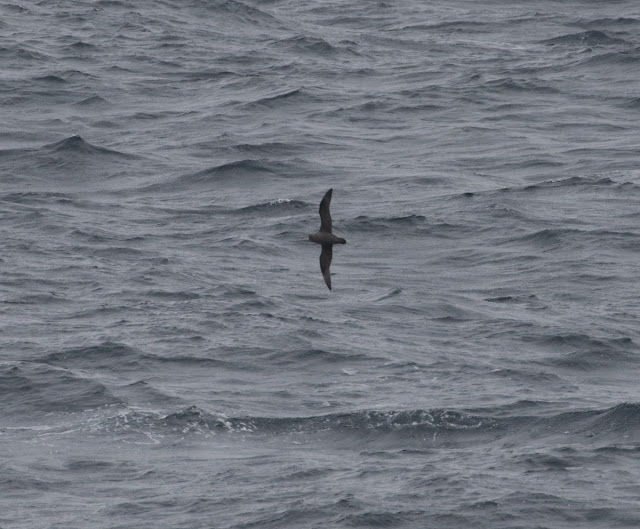My favourite uncle, at the time an ancient guy of almost 20, who had recently passed his driving test and bought a Mini was ripe for conversion to birding, so thought the much younger me. As he's still a birder 50 odd years later, I must have done a damn fine job. One of many new places the Mini allowed us to explore was the nearby County Durham (now Tyne and Wear) coast in the north east of England and our discovery of Marsden Rock was a jaw-dropping experience. So many birds! And, it was the first time I saw a tubenose. My uncle and I knew it was a tick, it had to be, but which tick was it? I was nudged and prodded forward to ask some people birding from the cliff-top whether I was right in thinking these fantastic birds were shearwaters. You'll appreciate how nervous I was when I tell you these people were birding with binoculars! They told me the birds were in fact Fulmars but congratulated me on my attempted identification because they were very similar to shearwaters. I came away with a puffed-out chest as well as a tick.
Northern Fulmar was, and still is, a fairly common breeder along that coastline and it became a common sight during my young birding life as I more often made trips down to the coast. Here in Japan I don't see them nearly so often as a ferry through northern waters is a must to catch up with them. My late spring seabirding sortie from Tomakomai to Hachinohe and back was just such a trip.
Distance, visibility and brevity of views all contributed to my confusion over the plumage types but even those seen well weren't always easily assigned as both active moult, which could expose pale feather bases in the coverts, and the presence of more than one generation of flight feathers producing a striking light and dark contrast within the same feather tract were all cause for befundlement for a morph novice. One bird that left no room for doubt, and the unquestionable fulmarine highlight, was a stunning treble light (LLL). It really was unlike any seabird I've seen in the northern hemiphere.
The familiar distribution of colour morphs I was aware of in the Atlantic is reversed in the Pacific, with the lighter morphs breeding in the northern parts of the range here whereas it's the darker morphs that are more frequent in the northern reaches of the Atlantic. Therefore ferry trips in Japan will yield far more dark birds. It's worth adding that while double dark (DD) and double light (LL) birds can be found in the Atlantic, the Pacific also holds both darker (treble dark, DDD) and lighter (treble light LLL) morphs.
Though, to be honest, quite where one D or L stops and the next one starts is a bit of a mystery to me. I never saw dark birds in the UK, or if I did I don't remember, so I was very pleased to see them when I first started seabirding in Japan but always being intent on finding something rarer than Fulmar on northern ferry runs I didn't think too much about morphs. Hence my tentative efforts to stick a label on these birds shouldn't be taken too seriously. This is also one of those occasions where a camera is indispensable trying to make sense of varied and complex patterns see briefly in a less than ideal conditions. No wonder birders used guns in the old days.
First up, images of the stunning LLL which looks so different to the Fulmars I'm used to seeing.
 |
 |
 |
 |
| What a stunner, luckily this LLL flew by during one of the less misty stretches. It's a pity it isn't a tick, it's certainly worthy in terms of appearance compared to the bird below. |
By contrast this next bird was arguably the clearest example of a DDD.
 |
 |
 |
| More than a little different and terrific bird to see. However, there are so many all dark Procellariidae in the Pacific, it can't quite compete with the above LLL. |
Flipping back to the light side, I'm uncertain whether this would be classed as an LLL or whether it isn't an LL with 'enhanced white' due to moult. Your guess is as good as mine, or knowledge better as the case may be.
 |
 |
 |
| It was the only other light of any degree on the trip and under other circumstances I'd have been delighted to see it but it does lack the pizazz of the first bird. |
All the other birds I saw and photographed were darks so they are clearly the expected type in those waters, in this season at least. I selected images of the following three birds not because they're insightful but simply because they were the best shots I could manage. Yes, really.
 |
| Bird 1 is quite uniformly dark on the underparts, I might pitch for DDD here. |
 |
 |
| Bird 2 colour contrast between outer and inner secondaries clearly showing they are different generations. |
 |
| Bird 3 looks like the outer secondaries have been replaced here but moult still ongoing. |
 |
| Bird 3 as it moves off into the murk. Many birds had mottled underparts to a greater or lesser extent, but all were dark overall. |






